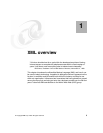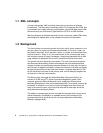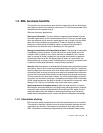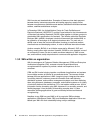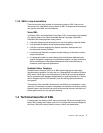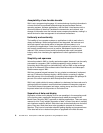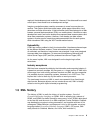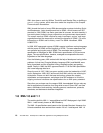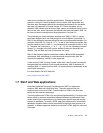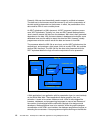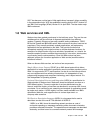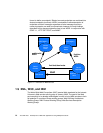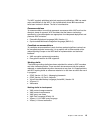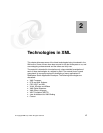10 The XML Files: Development of XML/XSL Applications Using WebSphere Studio
GML also drew on work by William Tunnicliffe and Stanley Rice on building a
generic coding system, which was done under the auspices of the Graphic
Communication Association.
GML formed the basis of many IBM documentation systems including Script
and Bookmaster. Later developments led to SGML, which became an ISO
standard in 1986. SGML has had a great deal of success, but unfortunately, it
has mainly been limited to large corporations and government departments.
The reason was that SGML required a major investment, and so, only large
organizations had the resources to achieve the benefits of SGML. For more
information on SGML and its history, read
The SGML Handbook
, ISBN
0198537379.
In 1996, W3C sponsored a group of SGML experts to define a markup language
with the power of SGML and the simplicity of HTML. The team abandoned the
non-essential and cryptic parts of SGML. The remainder was a cut-down
specification of 26 pages on XML. SGML had a specification of 500 and more
pages. The new specification, however, managed to conceptualize the main
ingredients of the older language.
Over the following years, XML evolved with the help of developers having similar
problems. At that time, Chemical Markup Language (CML) and MathML were
being formulated, and the eTensible Linking Language project was gaining
speed. Finally in 1998, the W3C approved Version 1.0 of the XML specification
and a new language was born.
Since the end of 1997, XML has grown quickly under the leadership of W3C,
and in September 1999, W3C announced that XML activity was entering its
third phase: Phase one built the base technology; phase two created
stylesheets and namespaces; and phase three will endeavor to finish the
ongoing work and introduce new specifications for an XML query standard.
Since then, as we know now, the usage of XML has exploded. We can only say
that its application will continue for a long while to come. Since 1997, we have
seen a multitude of tools evolving, including parsers, transformers, protocols,
standards, and business-to-business integration.
1.6 XML1.0 and 1.1
The working draft for XML 1.1 was published on W3C Web pages in April 2002.
XML 1.1 was formerly known as XML Blueberry.
The XML 1.0 specifications was based on the Unicode Standard. However, the
Unicode standards have evolved from version 2.0 to 3.1 and beyond. XML 1.0




